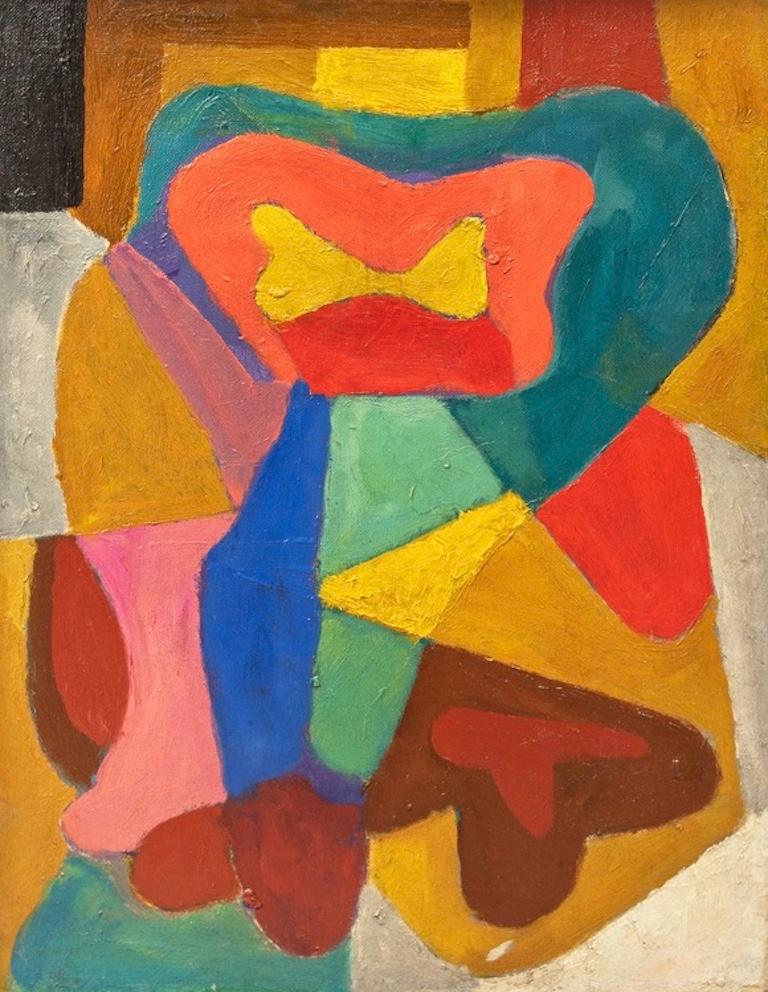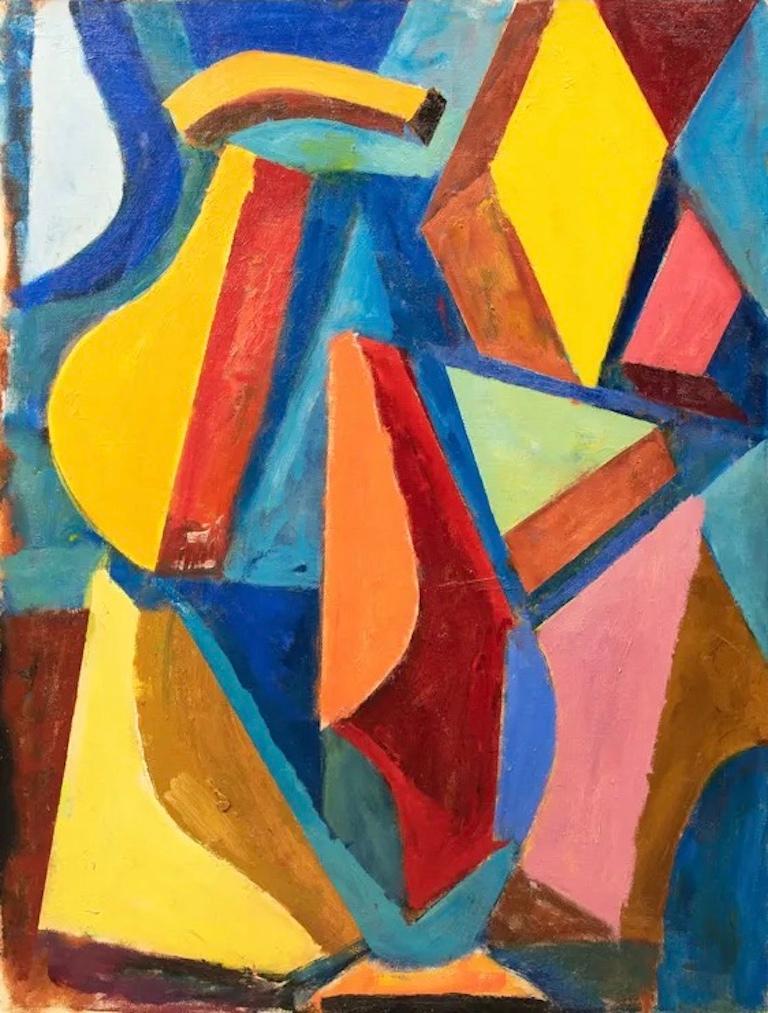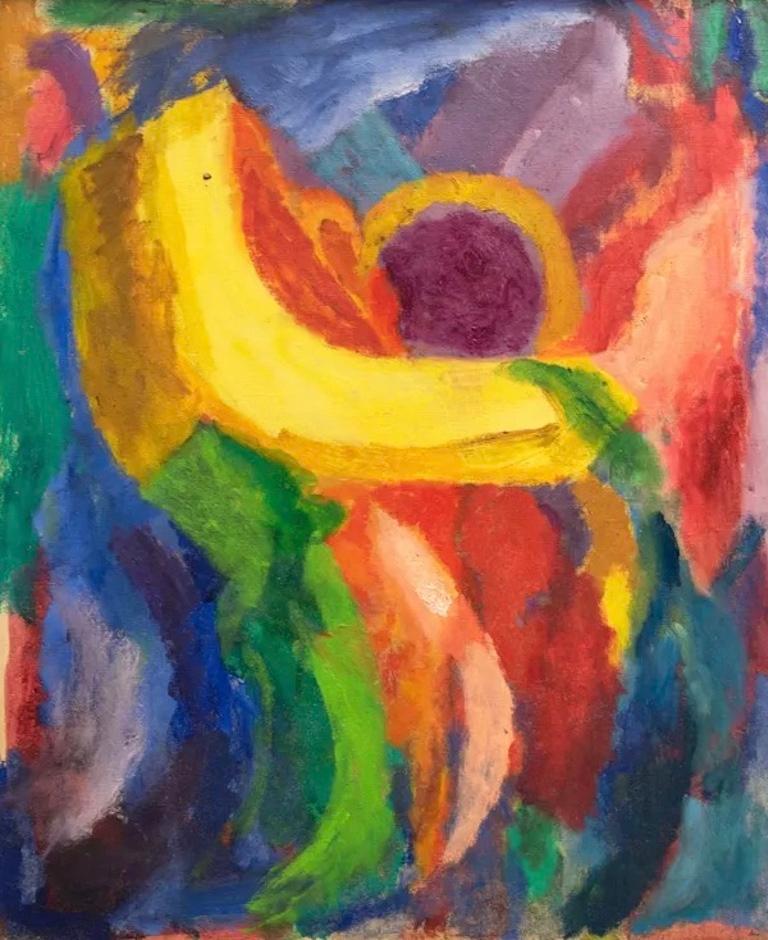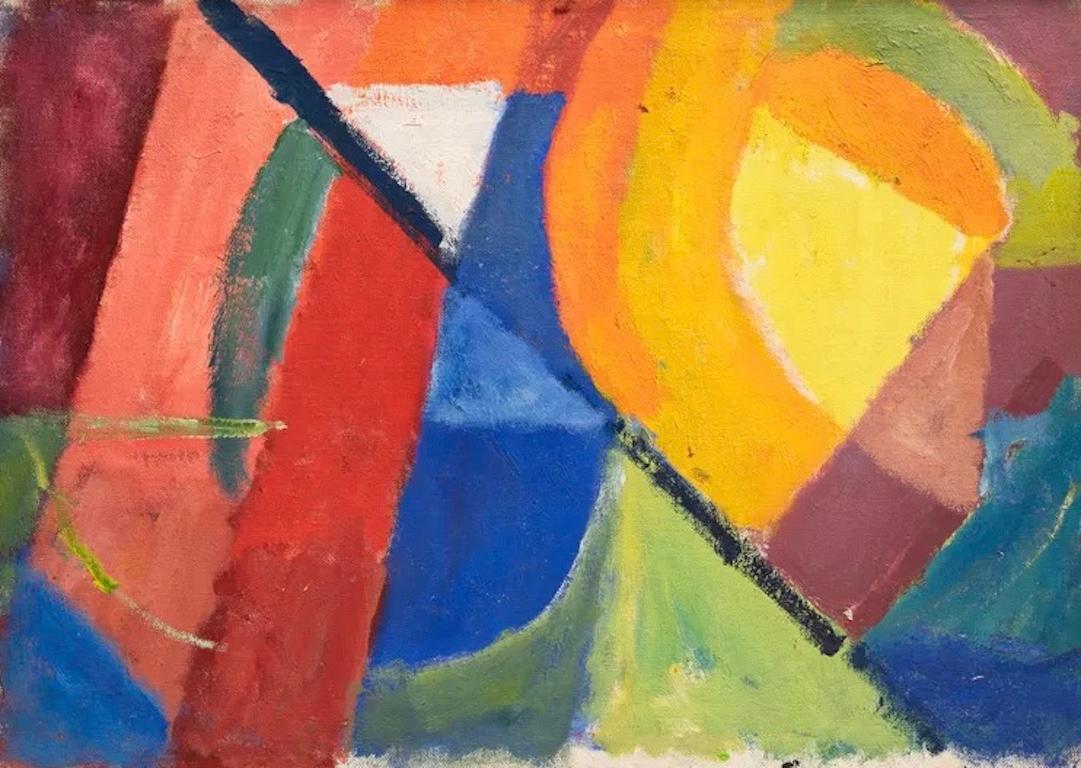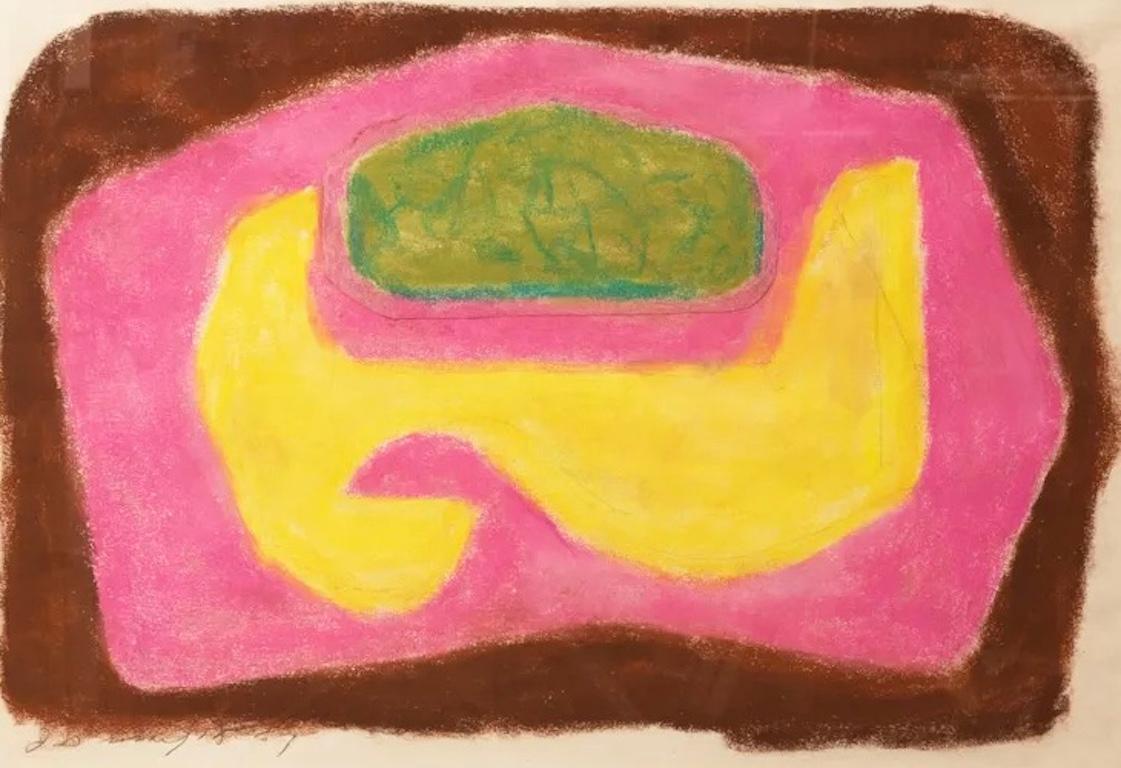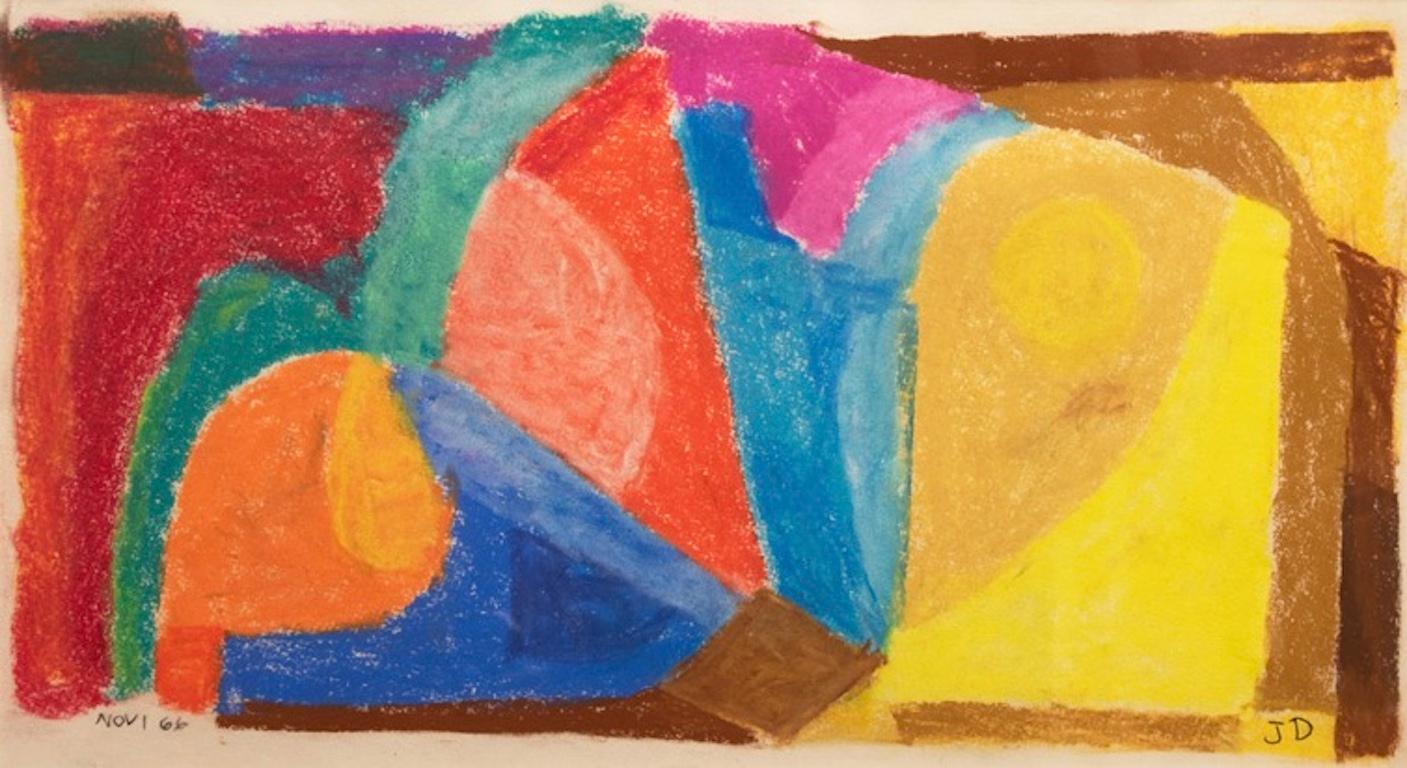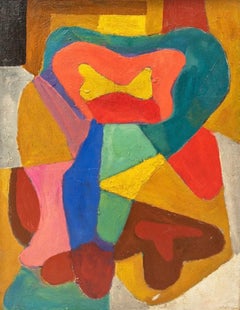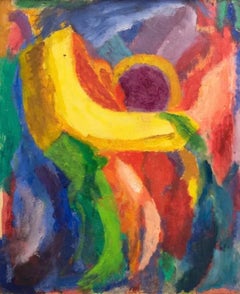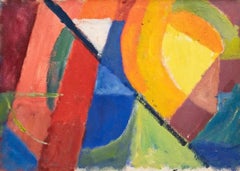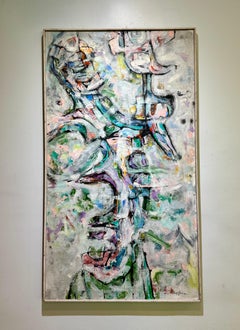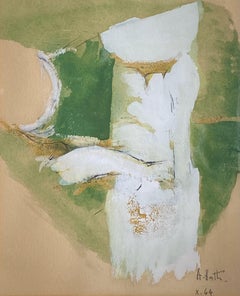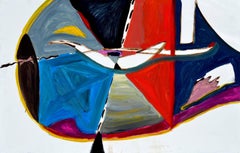Items Similar to "White Whale" Mid 20th Century American Abstract 1960s Color Field Abstraction
Want more images or videos?
Request additional images or videos from the seller
1 of 5
James Daugherty"White Whale" Mid 20th Century American Abstract 1960s Color Field Abstractionc. 1960's
c. 1960's
$10,500
£8,201.33
€9,297.19
CA$15,052.93
A$16,512.24
CHF 8,639.46
MX$196,528.50
NOK 109,121.63
SEK 102,358.04
DKK 69,436.61
About the Item
"White Whale" Mid 20th Century American Abstract 1960s Color Field Abstraction
James Daugherty (1887 – 1974)
"White Whale"
24 x 20 inches
Oil on panel, c. 1960s
Signed on the verso by Charles Daugherty, the artist’s son
Estate stamp verso
Provenance: Estate of the Artist.
BIO
Among the early American modernists, James Daugherty was one of the first exponents of abstract color painting. Throughout his career, whether he was working in an abstract or a representational mode, Daugherty felt pure color to be the most effective means of creating powerful and evocative works of art.
Daugherty was born in Asheville, North Carolina, near the Great Smoky Mountains. He received his formal training at the Corcoran School of Art in Washington, D.C. and at the Pennsylvania Academy of the Fine Arts in Philadelphia during the early years of the last century. Although he was in Europe from 1905 until 1907, he remained unaffected by avant-garde art until the groundbreaking Armory Show of 1913.
Daugherty worked in a futurist manner until late 1914 or early 1915, when he came into contact with Arthur B. Frost, Jr., who had recently returned from Paris, where he had worked closely with Robert and Sonia Delaunay, the inventors of Orphic Cubism. Inspired by Frost's example, Daugherty began to explore the use of pure color in conjunction with abstract design. He soon developed a style consisting of highly complex arrangements of strips, segments, and circles of color. Daugherty quickly became one of the foremost proponents of color painting and in turn, influenced other young American painters, including Jay Van Everen. During these years, Daugherty exhibited his work at the Society of Independent Artists in New York and later with the Société Anonyme, Inc.
In the 1920s, Daugherty responded to the call for indigenous subject matter by adopting a more figurative style while retaining his former emphasis on vibrant color. He subsequently produced numerous easel paintings and murals, most notably his Spirit of Cinema America (1920; Loew's State Theatre, Cleveland). He continued his mural work in to the 1930s, but eventually devoted much of his time to illustrating children's books.
In 1953 Daugherty once again began to create abstract paintings. The first of these works, small images with relatively stable compositions and subdued palettes, suggest the influence of the work of Piet Mondrian. By the end to the decade, Daugherty had expanded to larger formats and had broken from the grid to create increasingly complex designs. In the years that followed, he alternated modes, often joining his old rectilinear format of vertical and horizontal with circles and frequently using a lighter, more refined painterly touch and layered, almost transparent color planes that recall the color veils of Mark Rothko's art.
By the mid-1960s Daugherty's work reached a peak of size, complexity, and color intensity. The explosive energies of these paintings put into physical form what Daugherty called the "out rushing forces of the cosmos" in an "ever expanding infinitude." Fusing the old and the contemporary, Daughterty referred both to early modernism and to the abstract illusionism developed by younger artists in the 1960s such as Frank Stella, Al Held, and Ron Davis. Daugherty continued to paint until the end of his life, never ceasing to experiment and find ways that abstraction could "restore meaning to life and announce its beauty and capacity."
Examples of Daugherty's paintings can be found in many important public collections, including the Fine Arts Museums of San Francisco; Ackland Art Museum, University of North Carolina, Chapel Hill; Amon Carter Museum, Fort Worth, Texas; Asheville Art Museum, North Carolina; The Columbus Museum, Georgia; The Detroit Institute of Arts, Michigan; Flint Institute of Arts, Michigan; Heckscher Museum, Huntington, New York; Hirshhorn Museum and Sculpture Garden, Smithsonian Institution, Washington, D.C.; Hood Museum of Art, Dartmouth College, Hanover, New Hampshire; Hoover Institution, Stanford University, California; The Marion Koogler McNay Art Museum, San Antonio, Texas; The Montclair Art Museum, New Jersey; The Museum of Modern Art, New York; New Britain Museum of American Art, Connecticut; Portland Museum of Art, Maine; Sheldon Swope Art Museum, Terre Haute, Indiana; Smithsonian American Art Museum, Washington, D.C.; Société Anonyme Collection, Yale University Art Museum, New Haven, Connecticut; The Spencer Collection, The New York Public Library, New York; Stanford University, California; Telfair Academy of Arts and Sciences, Savannah, Georgia; and Whitney Museum of American Art, New York.
About the Seller
5.0
Vetted Professional Seller
Every seller passes strict standards for authenticity and reliability
Established in 2008
1stDibs seller since 2019
195 sales on 1stDibs
Typical response time: <1 hour
- ShippingRetrieving quote...Shipping from: Westport, CT
- Return Policy
More From This Seller
View All"Abstraction" Mid 20th Century American Abstract 1960s Color Field
Located in New York, NY
"Abstraction" Mid 20th Century American Abstract 1960s Color Field
James Daugherty (1887 – 1974)
Abstraction
16 x 12 inches
Estate stamp verso
Oil on panel
Provenance: Estate of t...
Category
1960s Abstract Abstract Paintings
Materials
Oil, Panel
"Gravity Zero" Mid 20th Century American Abstract 1960s Color Field Abstraction
Located in New York, NY
"Gravity Zero" Mid 20th Century American Abstract 1960s Color Field Abstraction
James Daugherty (1887 – 1974)
"Gravity Zero:
24 x 18 inches
Signed on verso
Oil on panel
Provenance...
Category
1960s Abstract Abstract Paintings
Materials
Oil, Panel
"Abstraction" Mid-20th Century American Abstract 1960s Color Field Modernist
Located in New York, NY
"Abstraction" Mid-20th Century American Abstract 1960s Color Field Modernist
James Daugherty (1887 – 1974)
Abstraction
24 x 20 inches
Estate stamp verso
Oil on panel
Provenance: ...
Category
1960s Abstract Abstract Paintings
Materials
Canvas, Oil
"Abstraction" Mid-20th Century American Abstract 1960s Color Field Modernist
Located in New York, NY
"Abstraction" Mid-20th Century American Abstract 1960s Color Field Modernist
James Daugherty (1887 – 1974)
Abstraction
14 x 18 inches
Estate stamp verso
Oil on panel
Provenance: ...
Category
1960s Abstract Abstract Paintings
Materials
Oil, Panel
"Untitled" Mid 20th Century American Abstract 1960s Color Field Abstraction
Located in New York, NY
"Untitled" Mid 20th Century American Abstract 1960s Color Field Abstraction
James Daugherty (1887 – 1974)
Untitled
15 x 21 ½ inches
May 15, 1967
Pastel on paper
Signed lower left
...
Category
1960s Abstract Abstract Drawings and Watercolors
Materials
Paper, Pastel
"Untitled" Mid 20th Century American Abstract 1960s Color Field Abstraction
Located in New York, NY
"Untitled" Mid 20th Century American Abstract 1960s Color Field Abstraction
James Daugherty (1887 – 1974)
Untitled
9 x 16 inches
Initialed lower right
Dated November 1, 1966 lower ...
Category
1960s Abstract Abstract Drawings and Watercolors
Materials
Paper, Pastel
You May Also Like
KUPFERMAN American Abstract 1959 Expressionist Painting
By Lawrence Kupferman
Located in New York, NY
Lawrence Kupferman (1909-1982) is an American Abstract painter and founder of the Boston Expressionist school. His work is included in the collections of the Museum of Modern Art, Mu...
Category
Mid-20th Century Abstract Abstract Paintings
Materials
Oil
Untitled. 1960's Abstract Mixed Media Painting
By Adrian Heath, 1920-1992
Located in Brecon, Powys
Adrian HEATH (1920-1992)
Untitled Composition
Mixed media
Signed and dated '64
Image 11.25" x 9"
Category
1960s Abstract Mixed Media
Materials
Paper, Pastel, Acrylic, Pencil
Lonistum 1961 - Canadian British Abstract art oil painting
By William John Bertram Newcombe
Located in Hagley, England
An original large abstract oil on canvas by British Canadian artist William John Bertram Newcombe. This stunning abstract expressionist oil in blues and greys is a bold, adventurous ...
Category
1960s Abstract Abstract Paintings
Materials
Mixed Media, Oil
$3,623 Sale Price
20% Off
Horizontal Abstract #4
By Leslie Luverne Anderson
Located in Soquel, CA
Bold abstract expressionist painting by Les (Leslie Luverne) Anderson (American, 1928-2009). Oil on masonite. Titled "For the Spouse no Longer in my House" on verso. From the estate ...
Category
1960s Post-War Abstract Paintings
Materials
Masonite, Oil
Large Budd Hopkins Modernist Hard Edged Abstract Expressionist Oil Painting 1965
Located in Surfside, FL
Budd Hopkins, American (1931-2011)
'City Sun II',
1969
Oil painting on canvas.
Hand signed and dated lower left.
Verso: Artist, title, and year in pencil on stretcher. Dimensions: 36" H x 52" w. Frame: 37.25" h x 53.25" w.
Budd Hopkins was one of the leading proponents of the "hard-edge" abstract minimalist school of painting in the 1950s and 1960s, Budd Hopkins (born 1931) created works that show the strong influence of Jackson Pollock and other leading painters of the Abstract Expressionism movement. Hopkins' paintings are now in numerous major collections, including the San Francisco Museum of Art, the Guggenheim Museum in New York, and the Hirshhorn Collection in Washington, DC.
Recently, he has also been recognized for his research into the matter of UFOs and one of his books, "The Intruders", printed by Random House, was on the New York Times best-seller list and was the basis for a television show on CBS.
Born in 1931, he is a graduate of Linsly Military Institute (now Linsly School) in 1949 and Oberlin College in 1953. He first displayed artistic abilities when, as a child recovering from a long-term illness, he began to create sculptures of ships made out of modeling clay. But it wasn't until he arrive at Oberlin that he made a serious study of art. Later, Hopkins included abstracted figures in his sculptural pieces. While moving away from Abstract Expressionism, Hopkins retained in his work the use of intense colors and hard-edged forms. His works of the 1980s, including Temples and Guardians, featured these "sentinels" who were, according to Hopkins, "participating in a frozen ritual, fixed – absolutely – within a privileged space..." Though Hopkins denied any connection, some critics viewed these ritualistic pieces as an extension of Hopkins' fascination with alien beings. Hopkins viewed his sculpted guardians not as human per se, but as magical, fierce, noble robots of the unconscious.
He settled in New York after obtaining his degree and has had a residence there ever since. He and his wife, April Kingsley, and their daughter, Grace, divide their time between their home at Cape Cod, Mass., and that in New York City. In his work, he travels widely. He has exhibited in England, Finland, Italy and Switzerland.
In 1963, Hopkins was selected by the Columbia Broadcasting System as one of the 15 painters featured in the network's first television special on American art. In 1958, Art News picked him as one of 12 Americans for exhibition in Spoleto, Italy, in the "Festival of Two Worlds."
His brilliance has won him a number of fellowships and awards. In 1972, the West Virginia Arts and Humanities Council awarded him its Commission Prize. In 1976, he received the John Simon Guggenheim Fellowship for Painting and in '79 he received a fellowship from the National Endowment of the Arts. He also won a special project grant from the New York State Council on the Arts in 1982. He was friends with Robert Ryman and many of the other 10th street avant garde artists. He was an original member of March Gallery which showed Alice Baber, Elaine de Kooning, Mark di Suvero, Lester Johnson, Matsumi Kanemitsu.
His work was handled by Poindexter Gallery. (a major gallery founded in 1955 in New York City by Elinor Poindexter. The gallery specialized in sculpture, abstract, and figurative art and featured the works of such artists as Richard Diebenkorn, Jules Olitski, Nell Blaine, Al Held, Willem de Kooning, Franz Kline, Earl Kerkam, Milton Resnick and Robert De Niro, among others.
His art has been featured in the Metropolitan Museum of Art, Museum of Modern Art, Bronx Museum of Art, Brooklyn Museum, Whitney Museum, Corcoran Gallery, Guggenheim Museum, Queens Museum in New York, and the Public Library of New York. He was included in Young America 1960: Thirty American Painters Under Thirty-Six buy Lloyd Goodrich at the Whitney Museum of American Art in NYC. Artists included: Sonia Gechtoff, Edward Giobbi, Ron Gorchov, James Harvey, Budd Hopkins, Wolf Kahn, Alex Katz, Robert Natkin, Rudy Pozzatti, Dean Richardson, Frank Roth, William Wiley, and Noriko Yamamoto...
Category
1960s Abstract Expressionist Abstract Paintings
Materials
Canvas, Oil
John Harvey McCracken Minimalist Abstract Oil on Canvas, 1973
By John McCracken
Located in Phoenix, AZ
Bright, exciting painting by well known New York/New Mexico/California artist John McCracken.
Framed simply and in excellent condition. Signed on the verso and dated 1973.
Painting m...
Category
Late 20th Century Abstract Paintings
Materials
Paint
More Ways To Browse
Mid Century Abstract Cubism Art
Vintage Whale
Whale Oil
Marais Painting
Mosaic Chicago
Nick Schleicher
Nikas Safronov
Ocean Surrealist Painting
Painting Forgiveness
Pennsylvania China
Pottery Shard
Queen Of Hearts Art
R Crumb
Robert Chapman
Square Paintings Gold Frames
Steve Lewis
Tall Abstract Painting Blue
Tantric Art
